- Summary---------------------------
Access
to lanthanide files
-
- On this page : an article by David Pier (USA)
"Exciting new transparent glaze colors using
Lanthanides Colorants"
- What
?------------------Why
?------------------How
?
-
- But what about toxicity
?
- Colored glaze recipes from David PIER :
- Cone
8-9 oxidation base glaze
-
- Cone
5-6 oxidation base glaze
-
- Cone
9-11 Celadon type glazes
-
- Materials
-
 FRENCH
VERSION FRENCH
VERSION-
-
|
EXCITING
NEW TRANSPARENT GLAZE COLORS USING LANTHANIDE
COLORANTS
by
David PIER (U.S.A).
|
-
-
-
-
- Thanks to David Pier who
had the kindness to send to us this new update of his
article on the lanthanide-colouring materials in
ceramic glazes.
- The French version was
carried out by Smart.Conseil (France) with the help of
Édouard Bastarache (Quebec).
-
- Smart2000
-
-
-
-
-
- Exciting
new transparent glaze colors using Lanthanide
Colorants :
-
- Vibrant colors with
unprecedented, amazing depth. These are not stains.
These are pure metal oxides, like copper, iron,
cobalt, and nickel oxides. They offer new
possibilities in transparent and translucent glaze
colors. Why haven't you ever heard of these metals, of
the oxides of neodymium, praseodymium, and erbium?
Because, until recently, these oxides were
prohibitively expensive and not widely sold. Not
anymore.
-
-
- What
?
-
- The lanthanides are the
elements numbered 58-71, 57-71 if lanthanum itself is
included. They're in the top of the two rows of the
section of the periodic table that is usually cut out
and shown below the rest of the periodic table. This
arrangement is done to make the table fit nicely on an
8.5x11 piece of paper. They always occur in mixed
mineral ores with yttrium and scandium oxides. The
lanthanides together with yttrium and scandium are
known as the rare earths. Despite
the name, many of these metals aren't actually very
rare. Their mixed ores occur in abundance in several
places in the world. Due to a recent feedback loop
between increases in mining and improved separation
technologies, the prices of all of these metals have
come down dramatically. Some of them don't give nice
colors or any color, some are more expensive than
gold, but neodymium, praseodymium, and erbium give
luscious new colors at affordable prices.
-
- Why
?
-
- First, what does the word
depth mean, when used in reference to
glazes? It is vague, but generally it is applied to a
group of glaze properties including transparency or
translucency, high refraction, and variation in
appearance due to variation in thickness of the glaze.
-
- - Refraction is when the
light changes direction when it passes into a
material, why your arm looks bent when you stick it
under water, and part of why diamonds (and glazes)
sparkle. More refraction is usually considered more
pleasing to the eye. More refractive glazes are also
glossier. Since the lanthanide oxides are very dense,
they are highly refractive, and they increase the
refraction of any glaze they are added to, increasing
sparkle and gloss.
- The color of transparent and
translucent glazes intensifies with thickness,
allowing the beautiful effects associated with celadon
glazes (traditionally colored with dissolved iron
oxide) such as highlighting incising and relief, and
fading on edges.
- - Transparency or
translucency let you easily see the crackle in a glaze
(called crazing if you don't like it). Pure metal
oxides, including the lanthanides, can dissolve in
molten glaze, just as food coloring dissolves in
water, leaving it colored but not cloudy. This means
the color will respond to the particular composition
of the glaze, and the glaze can remain transparent or
translucent if the colorant fully dissolves, which the
lanthanides can do.
- - Dissolved oxide colorants
are also much more sensitive to small changes in the
glaze, responding to base glaze composition, other
colorants, firing and cooling conditions, and the clay
body composition. This is in contrast to
stains, which are particles of very
particular multi-oxide composition that must remain
distinct within the glaze melt to retain their
particular color. This means that stains opacity as
they color, giving an effect similar to paint, an
appearance lacking "depth". Which would you rather
have, Pepto-Bismol or Pink Lemonade?
-
- To summarize, since these
newly available colorants are dense pure oxides, they
can give a variety of responsive transparent or
translucent colors with a depth
unavailable from stains.
-
-
- How
?
-
- Just as each of the
transition metal (e.g. copper, iron) colorants have
their own demands, the lanthanide metal colorants have
their own particulars, as a group, and as
individuals.
-
- A group characteristic of
the lanthanides is high density. This means that if
you don't add the right suspension additives to your
base glaze, these colorants will sink to the bottom of
the glaze bucket.
- I use a combination of
Veegum-T
and CMC gum. Veegum-T offers the advantages of
bentonite without the iron impurities. Since CMC is an
organic gum material, it offers many advantages
without affecting the fired glaze one bit (see
"Additives for Glazes and Clay Bodies" by Jeff Zamek,
December 1998 Ceramics Monthly). CMC takes some
getting used to, since it increases the viscosity of
the raw liquid glaze without making the glaze apply
thicker to the bisque. Note the suggested specific
gravities given in the recipes. Following them will
help assure proper application.
-
-
-
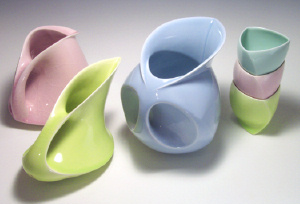 -
-
- All of the lanthanide oxides
have very high melting and boiling points, so that
they do not volatilize significantly under any normal
firing conditions.
- Although all of the
recipes I present here are high-fire, I have seen many
examples of these oxides used successfully in
low-fire, including Egyptian paste and raku
glazes. The considerations are the same as for use in
high-fire glazes.
-
- These oxides are
hygroscopic, meaning that they absorb atmospheric
moisture. This means that if you do not keep them in
tightly sealed containers before weighing, your
results will change slightly over time. If you buy a
large quantity, you might consider dividing it into
several small jars or zipper-seal bags.You might
notice a slight change in color due to the absorption
of water.
-
- My current understanding is
that a reduction atmosphere does not directly affect
these lanthanides. They are, however, sensitive to
trace amounts of transition metals, particularly iron,
and the oxidation states of these transition metals.
The net result is that the atmosphere affects their
appearance. Praseodymium might be an exception, its
color shifted to a greener, less yellow color by
reduction, but it is difficult to distinguish affects
of direct reduction from affects of trace
impurities.
-
- My crossover tests with the
traditional oxides is far from complete, but I have
found a few interesting things.
-
- Nd
(Neodymium): The
oxide is a blue/lavender powder. It is the strongest
of these three colorants, giving a good aqua color in
most glaze bases at 1-2%. At 4-7% it gives a pleasant
lavender/grape color that appears as a different color
under different artificial light sources. It is very
strongly affected by iron, particularly in oxidation,
giving a reliable perfect neutral transparent gray.
Avoid trace iron impurities to achieve the brightest
blue and lavender colors.
-
- Pr
(Praseodymium):
The oxide is a dark brown color. It gives a small
range of vibrant lime green colors in oxidation and
reduction at concentrations of 5-8%. In small amounts
(0.65%) in reduction with a trace of iron, gives a
bright spring green color. Other combinations with
transition metals have given either beige or no
effect.
-
- Er (Erbium):
The oxide is a
light baby pink color. It is the most expensive, the
densest, and the weakest of these three colorants, but
the only way you will ever get a transparent pink.
Erbium oxide's density means it is absolutely
essential that you use CMC gum. Erbium oxide gives its
best pink color at concentrations of 8-10%, but it is
difficult to get more than 8% to fully dissolve in the
melt. It has given a more lavender color in the
presence of iron traces in reduction.
-
-
- BUT WHAT
ABOUT TOXICITY?
-
- The exotic names and odd
placement in the periodic table lead people to imagine
radioactivity and heavy metal poisoning. In reality,
the pure lanthanide oxides are not radioactive and
have very low acute and chronic toxicity. It might
seem too good to be true, but the lanthanide oxides
pose significantly less of a toxic risk than the
commonly used transition metal oxides such as copper.
They also improve the strength and acid resistance of
the glaze. This doesn't mean that they're harmless.
Avoid ingestion, use proper respiratory protection,
and read the MSDS.
-
-
- THE LATEST
RECIPES:
-
-
- 1) Revised
PIER'S PURE LUX-DELUX Cone 8-9 oxidation base glaze
(v3.2003) :
-
-
-
-
-
- Coloration
:
-
-
- PIER'S PURE
LUX-DELUX PINK LEMONADE :
- Erbium Oxide
8.0
|
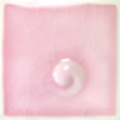
|
- PIER'S PURE
LUX-DELUX LIME CANDY :
- Praseodymium
Oxide 7
|
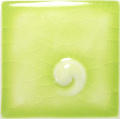
|
- PIER'S PURE
LUX-DELUX GRAPE CANDY :
- Neodymium Oxide
5.5
- Additional
#6
Tile
Kaolin
1.0
|
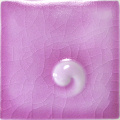
|
-
- Recommended specific gravity
for Pink Lemonade: 1.55 g/ml
- Recommended specific gravity
for Lime and Grape: 1.50 g/ml
-
- Notes
:
- - Takes two coats to look
its best, be sure to allow sufficient drying time
between coats to avoid water saturation of the bisque.
- - Slow firing for the last
few cones helps clear most of the bubbles
out.
- - I use an Orton small D10
in the kiln-sitter, which, whith a slow firing
schedule, is equivalent to a large visual D9, tip just
ouching the shelf.
- - CMC gum is almost
essential for suspension, particularly for erbium
oxide.
- - The copper carbonate is
present as a preservative for the CMC gum.
- - At cone 9, the glaze is a
bit runny, but perfectly clear. At cone 8, the glaze
is pretty stable, but not as fully transparent as at
cone 9.
- - This revision does not
craze on my porcelain body. If you want crazing
(crackle), try increasing the amount of frit 3110 and
decreasing frit 3289, or going back to my first
published recipes
- - The barium content of
these glazes is high for two reasons. (1) Barium has a
positive effect on the solubility (=transparency) of
the lanthanides in the glass. (2) Barium gives
glossier, more lustrous glazes due to its high index
of refraction. I have subjected these glazes to strong
acid and base conditions far in excess of any the
glaze would normally encounter, and there was no
measurable leaching. These glazes are safe if mixed
properly and fired to maturity.
- - As discussed in the main
body of this article, the lanthanide colors are not
extremely sensitive to the choice of fluxing oxides.
The fluxes used in this recipe are chosen for their
positive effect on lanthanide solubility
(=transparency) and other glaze properties such as
fit, hardness, and gloss.
-
-
- 2) Cone 5-6
OXIDATION BASE GLAZE
-
-
-
-
- Notes
:
-
- - Colorant additions and
recommended specific gravities are the same as for the
cone 8-9 base glaze. These glazes are not pictured in
this article, but the colors are identical to the cone
8-9 oxidation glazes.
- - I use an Orton small D10
in the kiln-sitter, which, whith a slow firing
schedule, is equivalent to a large visual D9, tip just
ouching the shelf.
- - All other information
given in the notes on the cone 8-9 glazes apply to
these cone 5-6 glazes.
-
- 3) Cone 9-11
CELADON TYPE GLAZES :
-
|
Components
:
|
Quantity
:
|
|
Custer
feldspar
|
27.5
|
|
Grolleg
kaolin
(ECC-UK)
|
20.0
|
|
Wollastonite
|
26.0
|
|
Silica 325
mesh
|
24.0
|
|
Zircopax
(ZrSiO4)
|
1.0
|
|
Veegum-T
|
1.5
|
|
-
|
100
%
|
|
CMC gum
|
0.40
|
|
Copper
carbonate
|
0.02
|
-
-
- Coloration :
-
-
- For PIER'S
UNREAL GREEN CELADON (Reduction)
Add:
- Praseodymium
Oxide 0.65
|
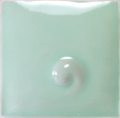
|
- For PIER'S
UNREAL BLUE CELADON (Reduction)
Add:
- Neodymium Oxide
1.1
|
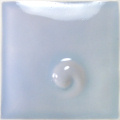
|
- For PIER'S
BLUE-GREEN CELADON (reduction) Add
:
- Spanish Red Iron
Oxide 0.07
- (or any other
red iron, ball milled)
|

|
- For PIER'S
APPARENTLY LAVENDER CELADON (Oxidation)
Add:
- Neodymium Oxide
4.5
|
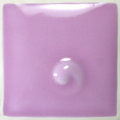
|
-
-
- Notes :
- - Trouble free, usually
craze-free, very reliable glaze base.
- - Recommended specific
gravity for all four : 1.5 g/ml
- - You can get away without
using the CMC gum is these glazes, but it helps with
even application as well as suspension.
- - Erbium and higher
concentrations of Praseodymium are not used to their
best advantage in this glaze base (dull colors,
partially due to lower solubility of the lanthanides
in this glass).
- - Apply fairly thick, two to
four coats, allowing time to dry between
coats.
- - If your wollastonite has
an appreciable iron impurity, you can get an even
cleaner color from the neodymium glazes (blue and
lavander) if you make the following replacement :
(26.0% Wollastonite) = (22.4% Whiting + 13.4% 325 mesh
Silica).
- - The "apparently" in
Apparently Lavender Celadon refers to its
interesting property of dramatically changing color
(from lavender to green to bright blue to bright
purple) under different lighting types.
-
-
-
- David PIER - USA / March
2003 (v3. 2003)
- dapier@yahoo.com
-
-
-
-
-
-
- Materials
:
-
-
- Grolleg
kaolin (ecc-UK) : % 0.10 Na2O 1.90 K2O 0.10 CaO
0.30 MgO 37.00 Al2O3 48.00 SiO2 0.03 TiO2 0.70 Fe2O3
12.01 LOI
- # 6
Tile Kaolin ( A secondary (sedimentary) kaolin.
Manufactured by Georgia Kaolin Co.) : % 0.04 Na2O 0.58
MgO 0.43 CaO 38.20 Al2O3 46.90 SiO2 1.42 TiO2 0.35
Fe2O3 13.90 LOI
- Spanish
Red Iron Oxide (Spanish RIO) : Oxyde de fer
"Malaga" broyé.
- 3289
Ferro Frit : % 5.5 Na2O 27.4 BaO 12.4 B2O3
5.4 Al2O3 49.3 SiO2
- 3110
Ferro Frit : % 2.3 K2O 15.3 Na2O 6.3 CaO 2.6 B2O3
3.7 Al2O3 69.8 SiO2
- 3124
Ferro Frit : % 0.7 K2O 6.3 Na2O 14.1 CaO 13.7 B2O3
9.9 Al2O3 55.3 SiO2
- Custer
Feldspar : Commonly used potash feldspar. Can be
used to substitute for Keystone, Buckingham, Yankee,
or Kingman feldspars. Composition % 2.91 Na2O 10.28
K2O 0.30 CaO 17.35 Al2O3 69.00 SiO2 0.12 Fe2O3 0.04
Loss on ignition.
- Veegum
T : Veegum is not a 'gum', rather it is a
montmorillonite mineral called 'smectite' (bentonite
and hectorite are similar minerals). It is a complex
colloidal and extremely plastic magnesium aluminum
silicate. It is an off-white insoluble flake magnesium
aluminum silicate that swells to many times its
original volume when added to water. Its aqueous
dispersions are thus high viscosity thixotropic gels
at low solids. Veegum is not subject to attack by
microorganisms. Various grades are classified
according to viscosity and ratio of aluminum to
magnesium content.
- See more on Tony Hansen
web site :
https://digitalfire.com/material/1672
-
-
-
- Smart2000.fr
©
Avril
2003
-
FRANCE
- Contact
: Smart2000@wanadoo.fr
- Document
pour CONSULTATION PRIVÉE uniquement - Toute
reproduction totale ou partielle est
interdite
-
-
-
-
- Smart2000.fr
le site
dédié aux passionnés de
céramique
-
- Smart2000
- FRANCE sur https://smart2000.fr/
-
- This
entire page Copyright © 2003-2023, All Rights
Reserved.
- Les
textes et les photos restent la
propriété de leur auteurs, ils ne
peuvent être réutilisés sans un
accord préalable. Nous
consulter.
|